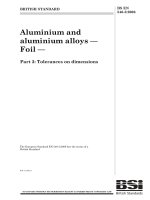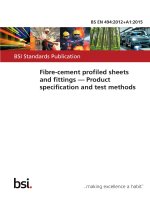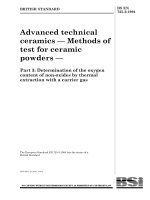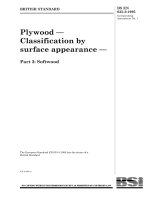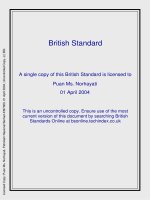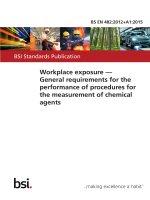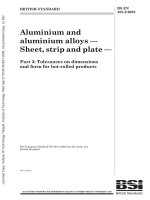Bsi bs en 61300 3 35 2015
Bạn đang xem bản rút gọn của tài liệu. Xem và tải ngay bản đầy đủ của tài liệu tại đây (2.15 MB, 26 trang )
BS EN 61300-3-35:2015
BSI Standards Publication
Fibre optic interconnecting
devices and passive
components — Basic test
and measurement
procedures
Part 3-35: Examinations and measurements
—Visual inspection of fibre optic connectors
and fibre-stub transceivers
BRITISH STANDARD
BS EN 61300-3-35:2015
National foreword
This British Standard is the UK implementation of EN 61300-3-35:2015. It is
identical to IEC 61300-3-35:2015. It supersedes BS EN 61300-3-35:2010
which is withdrawn.
The UK participation in its preparation was entrusted by Technical
Committee GEL/86, Fibre optics, to Subcommittee GEL/86/2, Fibre optic
interconnecting devices and passive components.
A list of organizations represented on this committee can be obtained on
request to its secretary.
This publication does not purport to include all the necessary provisions of
a contract. Users are responsible for its correct application.
© The British Standards Institution 2015.
Published by BSI Standards Limited 2015
ISBN 978 0 580 72740 5
ICS 33.180.20
Compliance with a British Standard cannot confer immunity from
legal obligations.
This British Standard was published under the authority of the
Standards Policy and Strategy Committee on 31 October 2015.
Amendments/corrigenda issued since publication
Date
Text affected
BS EN 61300-3-35:2015
EUROPEAN STANDARD
EN 61300-3-35
NORME EUROPÉENNE
EUROPÄISCHE NORM
October 2015
ICS 33.180.20
Supersedes EN 61300-3-35:2010
English Version
Fibre optic interconnecting devices and passive components Basic test and measurement procedures - Part 3-35:
Examinations and measurements - Visual inspection of fibre
optic connectors and fibre-stub transceivers
(IEC 61300-3-35:2015)
Dispositifs d'interconnexion et composants passifs à fibres
optiques - Procédures fondamentales d'essais et de
mesures - Partie 3-35: Examens et mesures - Examen
visuel des connecteurs à fibres optiques et des émetteursrécepteurs à embase fibrée
(IEC 61300-3-35:2015)
Lichtwellenleiter - Verbindungselemente und passive
Bauteile - Grundlegende Prüf- und Messverfahren - Teil 335: Untersuchungen und Messungen - Visuelle Inspektion
von Lichtwellenleiter-Steckverbindern und Faser StubTransceivern
(IEC 61300-3-35:2015)
This European Standard was approved by CENELEC on 2015-07-30. CENELEC members are bound to comply with the CEN/CENELEC
Internal Regulations which stipulate the conditions for giving this European Standard the status of a national standard without any alteration.
Up-to-date lists and bibliographical references concerning such national standards may be obtained on application to the CEN-CENELEC
Management Centre or to any CENELEC member.
This European Standard exists in three official versions (English, French, German). A version in any other language made by translation
under the responsibility of a CENELEC member into its own language and notified to the CEN-CENELEC Management Centre has the
same status as the official versions.
CENELEC members are the national electrotechnical committees of Austria, Belgium, Bulgaria, Croatia, Cyprus, the Czech Republic,
Denmark, Estonia, Finland, Former Yugoslav Republic of Macedonia, France, Germany, Greece, Hungary, Iceland, Ireland, Italy, Latvia,
Lithuania, Luxembourg, Malta, the Netherlands, Norway, Poland, Portugal, Romania, Slovakia, Slovenia, Spain, Sweden, Switzerland,
Turkey and the United Kingdom.
European Committee for Electrotechnical Standardization
Comité Européen de Normalisation Electrotechnique
Europäisches Komitee für Elektrotechnische Normung
CEN-CENELEC Management Centre: Avenue Marnix 17, B-1000 Brussels
© 2015 CENELEC All rights of exploitation in any form and by any means reserved worldwide for CENELEC Members.
Ref. No. EN 61300-3-35:2015 E
BS EN 61300-3-35:2015
EN 61300-3-35:2015
European foreword
The text of document 86B/3886/FDIS, future edition 2 of IEC 61300-3-35, prepared by SC 86B “Fibre
optic interconnecting devices and passive components” of IEC/TC 86 “Fibre optics" was submitted to
the IEC-CENELEC parallel vote and approved by CENELEC as EN 61300-3-35:2015.
The following dates are fixed:
•
latest date by which the document has to be
implemented at national level by
publication of an identical national
standard or by endorsement
(dop)
2016-04-30
•
latest date by which the national
standards conflicting with the
document have to be withdrawn
(dow)
2016-07-30
This document supersedes EN 61300-3-35:2010.
Attention is drawn to the possibility that some of the elements of this document may be the subject of
patent rights. CENELEC [and/or CEN] shall not be held responsible for identifying any or all such
patent rights.
Endorsement notice
The text of the International Standard IEC 61300-3-35:2015 was approved by CENELEC as a
European Standard without any modification.
In the official version, for Bibliography, the following notes have to be added for the standards
indicated:
2
IEC 60825-2
NOTE
Harmonized as EN 60825-2
IEC 61300-1
NOTE
Harmonized as EN 61300-1
IEC 61755 (Series)
NOTE
Harmonized as EN 61755 (Series)
–2–
BS EN 61300-3-35:2015
IEC 61300-3-35:2015 © IEC 2015
CONTENTS
FOREWORD ........................................................................................................................... 4
1
Scope .............................................................................................................................. 6
2
Normative references ...................................................................................................... 6
3
Terms, definitions and abbreviations ............................................................................... 6
3.1
Terms and definitions .............................................................................................. 6
3.2
Abbreviations .......................................................................................................... 7
4
Measurement ................................................................................................................... 7
4.1
General ................................................................................................................... 7
4.2
Measurement conditions ......................................................................................... 7
4.3
Pre-conditioning ...................................................................................................... 7
4.4
Recovery ................................................................................................................ 7
5
Apparatus ........................................................................................................................ 8
5.1
Method A: Direct view optical microscopy ............................................................... 8
5.2
Method B: Video microscopy ................................................................................... 8
5.3
Method C: Automated analysis microscopy ............................................................. 8
5.4
Certification requirements for low and high resolution systems ............................... 8
5.4.1
General ........................................................................................................... 8
5.4.2
Requirement for low resolution microscope systems ........................................ 8
5.4.3
Requirements for high resolution microscope systems ..................................... 9
6
Procedure ........................................................................................................................ 9
6.1
6.2
6.3
Annex A
Certification procedure ............................................................................................ 9
Inspection procedure .............................................................................................. 9
Visual requirements .............................................................................................. 10
(informative) Examples of inspected end faces with surface anomalies .................. 13
Annex B (normative) Diagram of qualification artefact and method of manufacture .............. 18
B.1
High resolution artefact ......................................................................................... 18
B.2
Low resolution artefact .......................................................................................... 20
Bibliography .......................................................................................................................... 21
Figure 1 – Inspection procedure flow .................................................................................... 10
Figure A.1 – Example 1 (low resolution system) .................................................................... 13
Figure A.2 – Example 1 (high resolution system) .................................................................. 13
Figure A.3 – Example 2 (low resolution system) .................................................................... 14
Figure A.4 – Example 2 (high resolution system) .................................................................. 14
Figure A.5 – Example 3 (low resolution system) .................................................................... 14
Figure A.6 – Example 3 (high resolution system) .................................................................. 15
Figure A.7 – Example 4 (low resolution system) .................................................................... 15
Figure A.8 – Example 4 (high resolution system) .................................................................. 16
Figure A.9 – Example 5 (low resolution system) .................................................................... 16
Figure A.10 – Example 6 (low resolution system) .................................................................. 17
Figure B.1 – Example of nano-indentation test system .......................................................... 18
Figure B.2 – Example of high resolution artefacts ................................................................. 19
Figure B.3 – Example of low resolution artefact pattern ........................................................ 20
BS EN 61300-3-35:2015
IEC 61300-3-35:2015 © IEC 2015
–3–
Table 1 – Visual requirements for single-mode PC polished connectors, RL ≥ 45 dB ........... 11
Table 2 – Visual requirements for single-mode angle polished (APC) connectors .................. 11
Table 3 – Visual requirements for single-mode PC polished connectors, RL ≥ 26 dB
and single-mode transceivers using a fibre-stub interface ..................................................... 12
Table 4 – Visual requirements for multi-mode PC polished connectors .................................. 12
–4–
BS EN 61300-3-35:2015
IEC 61300-3-35:2015 © IEC 2015
INTERNATIONAL ELECTROTECHNICAL COMMISSION
____________
FIBRE OPTIC INTERCONNECTING
DEVICES AND PASSIVE COMPONENTS –
BASIC TEST AND MEASUREMENT PROCEDURES –
Part 3-35: Examinations and measurements –
Visual inspection of fibre optic connectors and fibre-stub transceivers
FOREWORD
1) The International Electrotechnical Commission (IEC) is a worldwide organization for standardization comprising
all national electrotechnical committees (IEC National Committees). The object of IEC is to promote
international co-operation on all questions concerning standardization in the electrical and electronic fields. To
this end and in addition to other activities, IEC publishes International Standards, Technical Specifications,
Technical Reports, Publicly Available Specifications (PAS) and Guides (hereafter referred to as “IEC
Publication(s)”). Their preparation is entrusted to technical committees; any IEC National Committee interested
in the subject dealt with may participate in this preparatory work. International, governmental and nongovernmental organizations liaising with the IEC also participate in this preparation. IEC collaborates closely
with the International Organization for Standardization (ISO) in accordance with conditions determined by
agreement between the two organizations.
2) The formal decisions or agreements of IEC on technical matters express, as nearly as possible, an international
consensus of opinion on the relevant subjects since each technical committee has representation from all
interested IEC National Committees.
3) IEC Publications have the form of recommendations for international use and are accepted by IEC National
Committees in that sense. While all reasonable efforts are made to ensure that the technical content of IEC
Publications is accurate, IEC cannot be held responsible for the way in which they are used or for any
misinterpretation by any end user.
4) In order to promote international uniformity, IEC National Committees undertake to apply IEC Publications
transparently to the maximum extent possible in their national and regional publications. Any divergence
between any IEC Publication and the corresponding national or regional publication shall be clearly indicated in
the latter.
5) IEC itself does not provide any attestation of conformity. Independent certification bodies provide conformity
assessment services and, in some areas, access to IEC marks of conformity. IEC is not responsible for any
services carried out by independent certification bodies.
6) All users should ensure that they have the latest edition of this publication.
7) No liability shall attach to IEC or its directors, employees, servants or agents including individual experts and
members of its technical committees and IEC National Committees for any personal injury, property damage or
other damage of any nature whatsoever, whether direct or indirect, or for costs (including legal fees) and
expenses arising out of the publication, use of, or reliance upon, this IEC Publication or any other IEC
Publications.
8) Attention is drawn to the Normative references cited in this publication. Use of the referenced publications is
indispensable for the correct application of this publication.
9) Attention is drawn to the possibility that some of the elements of this IEC Publication may be the subject of
patent rights. IEC shall not be held responsible for identifying any or all such patent rights.
International Standard IEC 61300-3-35 has been prepared by subcommittee SC86B: Fibre
optic interconnecting devices and passive components, of IEC technical committee 86: Fibre
optics.
This second edition cancels and replaces the first edition published in 2009 and constitutes a
technical revision.
This edition includes the following significant technical changes with respect to the previous
edition:
a) modification to the title;
b) addition of some terms and definitions;
BS EN 61300-3-35:2015
IEC 61300-3-35:2015 © IEC 2015
–5–
c) reconsideration of the specific values of Tables 1 to 4 to reflect the current market
situation;
d) addition of visual requirements for single-mode transceivers using a fibre-stub interface in
Table 3;
e) addition of a sentence in 4.1 concerning the susceptibilty of the methods to system
variability.
The text of this standard is based on the following documents:
FDIS
Report on voting
86B/3886/FDIS
86B/3912/RVD
Full information on the voting for the approval of this standard can be found in the report on
voting indicated in the above table.
This publication has been drafted in accordance with the ISO/IEC Directives, Part 2.
A list of all parts in the IEC 61300 series, published under the general title Fibre optic
interconnecting devices and passive components – Basic test and measurement procedures,
can be found on the IEC website.
The committee has decided that the contents of this publication will remain unchanged until
the stability date indicated on the IEC web site under "" in the data
related to the specific publication. At this date, the publication will be
•
reconfirmed,
•
withdrawn,
•
replaced by a revised edition, or
•
amended.
IMPORTANT – The 'colour inside' logo on the cover page of this publication indicates
that it contains colours which are considered to be useful for the correct
understanding of its contents. Users should therefore print this document using a
colour printer.
–6–
BS EN 61300-3-35:2015
IEC 61300-3-35:2015 © IEC 2015
FIBRE OPTIC INTERCONNECTING
DEVICES AND PASSIVE COMPONENTS –
BASIC TEST AND MEASUREMENT PROCEDURES –
Part 3-35: Examinations and measurements –
Visual inspection of fibre optic connectors and fibre-stub transceivers
1
Scope
This part of IEC 61300 describes methods for quantitatively assessing the end face quality of
a polished fibre optic connector or of a fibre optic transceiver using a fibre-stub type interface.
Sub-surface cracks and fractures are not considered in this standard. In general, the methods
described in this standard apply to 125 µm cladding fibres contained within a ferrule and
intended for use with sources of ≤ 2 W of input power. However, portions are applicable to
non-ferruled connectors and other fibre types. Those portions are identified where appropriate.
It is not the intention of this standard that the size of scratches should be measured, the
dimensions and requirements are selected such that they can be estimated. There is no need
to measure for example if a scratch is 2,3 µm wide.
2
Normative references
The following documents, in whole or in part, are normatively referenced in this document and
are indispensable for its application. For dated references, only the edition cited applies. For
undated references, the latest edition of the referenced document (including any
amendments) applies.
Void.
3
3.1
Terms, definitions and abbreviations
Terms and definitions
For the purposes of this document, the following terms and definitions apply.
3.1.1
defect
non-linear surface feature detectable on the end face of ferrule including particulates, other
debris, fluid contamination, pits, chips, edge chipping, etc.
Note 1 to entry: Some fibre types have structural features potentially visible on the fibre end face. Fibres that use
microstructures to contain the light signal, such as photonic band-gap and hole-assisted fibres, can have an
engineered or random pattern of structures surrounding the core. These features are not defects.
3.1.2
defect size
smallest circle that can encompass the entire defect
3.1.3
loose debris
particulate and debris that can be removed by cleaning
Note 1 to entry:
Loose debris are classified as defects.
BS EN 61300-3-35:2015
IEC 61300-3-35:2015 © IEC 2015
–7–
3.1.4
scratch
a permanent linear surface feature where the fiber or ferrule end face has been damaged or
removed, and where the width of the damaged area is small compared to its length
3.1.5
reliably detectable
sufficiently clear and visible so that a typical technician of average training would recognize
the feature at least 98 % of the time.
3.2
Abbreviations
Term
Description
DUT
Device under test
FOV
Field of view
4
4.1
Measurement
General
The objective of this standard is to prescribe methods for quantitatively inspecting fibre optic
end faces to determine if they are suitable for use. Three methods are described:
A. direct view optical microscopy as described in 5.1;
B. video microscopy as described in 5.2;
C. automated analysis microscopy as described in 5.3.
Within each method, there are hardware requirements and procedures for both low resolution
and high resolution systems. Low resolution systems should be used for examination of
single-mode and multi-mode connectors prior to mating and after polishing. High resolution
systems may be used for end face inspection in the factory after polishing of single-mode
connectors. High resolution systems are not required for inspection in the field nor for
inspection of multi-mode connectors nor for field polished connectors.
For Methods A and B, it is recommended that visual gauge tools be developed to facilitate the
measurement procedure. For Method A, an eyepiece reticule is recommended. For Method B,
an overlay is recommended.
All methods are susceptible to system variability: Methods A and B are operator dependent;
Method C is operator independent.
4.2
Measurement conditions
No restrictions are placed on the range of atmospheric conditions under which the test can be
conducted. It may be performed in controlled or uncontrolled environments provided that the
end faces are carefully cleaned before the test.
4.3
Pre-conditioning
No pre-conditioning time is required.
4.4
Recovery
No minimum recovery time is required.
–8–
5
BS EN 61300-3-35:2015
IEC 61300-3-35:2015 © IEC 2015
Apparatus
5.1
Method A: Direct view optical microscopy
This method utilizes an optical microscope in which a primary objective lens forms a first
image that is then magnified by an eyepiece that projects the image directly to the user’s eye.
It shall have the following features and capabilities:
•
a suitable ferrule or connector adapter;
•
a light source and focusing mechanism;
•
a built-in laser safety filter.
Laser safety is of particular concern when using direct view microscopes, as any energy in the
optical path is directed into the eye of the observer. If Method A is used the user shall ensure
there is no laser active on the link prior to inspection. See IEC 60825-2 for laser safety of
optical fibre communication systems.
5.2
Method B: Video microscopy
This method utilizes an optical microscope in which a lens system forms an image on a
sensor that, in turn, transfers the image to a display. The user views the image on the display.
It shall have the following features and capabilities:
•
a suitable ferrule or connector adapter;
•
a light source and focusing mechanism;
•
a means to measure surface anomalies observed in the image.
5.3
Method C: Automated analysis microscopy
This method utilizes an optical microscope in which a digital image is acquired or created and
subsequently analysed via an algorithmic process. The purpose of such a system is to reduce
the effects of human subjectivity in the analysis process. It shall have the following features
and capabilities:
•
a suitable ferrule or connector adapter;
•
a means for acquiring or creating a digital image;
•
algorithmic analysis of the digital image;
•
a means to compare the analysed image to programmable acceptance criteria in such a
manner that a result of “pass” or “fail” is provided.
5.4
5.4.1
Certification requirements for low and high resolution systems
General
Microscope systems for Methods A, B and C shall be certified for use in either low or high
resolution applications. This certification shall be conducted with a purpose-built certification
artefact that can serve to validate a system’s ability to detect surface anomalies of relevant
size. Such an artefact shall be provided with instructions on its use and shall be manufactured
in a method such that it can be measured in a traceable manner. Details of the manufacture of
such artefacts can be found in Annex B.
5.4.2
Requirement for low resolution microscope systems
This requirement is a minimum total magnification offering a field of view (FOV) of at least
250 µm (for Methods B and C, this dimension shall be measured in the vertical, or most
constrained, axis) capable of detecting defects of 2 µm in diameter.
BS EN 61300-3-35:2015
IEC 61300-3-35:2015 © IEC 2015
5.4.3
–9–
Requirements for high resolution microscope systems
These requirements are a minimum total magnification offering a field of view of at least
120 µm (for Methods B and C, this dimension shall be measured in the vertical, or most
constrained, axis) capable of detecting scratches 1 µm in width. A system with FOV less than
250 µm will require scrolling/panning of the end face or subsequent inspection with a larger
FOV system to meet the full requirements of this standard.
6
6.1
Procedure
Certification procedure
On commissioning, and periodically during its life, the microscope system shall be certified.
Fix the artefact(s) on the microscope system and focus the image.
Follow the manufacturer’s instructions on how to certify the system using the artefact.
Generally, this should entail viewing the artefact and verifying that the small features and
contrast targets are “reliably detectable”; and that the region of interest can be fully viewed or
scanned.
For automated systems, software utilities to perform this certification shall be provided. In any
event, these systems shall be able to perform the same certification so as to validate the fact
that they can reliably detect the features of the artefact.
6.2
Inspection procedure
It is recommended that the complete ferrule end face be inspected for cleanliness and
absence of loose debris. This is especially important for rectangular ferrules such as MT
ferrules. Use of inspection equipment with large FOV of and oblique illumination eases the
detection of loose particles. This inspection for cleanliness should take place prior the
inspection of the polished end faces.
Figure 1 shows a flowchart which describes the following procedure which shall be employed.
•
Focus the microscope so that a crisp image can be seen.
•
Align the inspection zones prescribed within the inspection criteria with the outer edge of
the optical fibre.
•
Locate all defects and scratches within the zones as specified in the relevant Tables of 6.3.
Count and measure defects and count scratches within each zone. Exclude from analysis
all defects contained within the zone covering the interface between fibre and ferrule
(Zone C: adhesive). In the context of this standard, “none” means no scratch or defect
detectible by the qualified inspection system.
•
Once all defects and scratches have been quantified, the results should be totalled by
zone and compared with the appropriate acceptance criteria (see Tables 1 to 4). If a
defect is found to be in more than one zone, apply the scratch/defect to the most stringent
zone and exclude from further analysis.
•
Any end face with quantified defects or scratches in excess of the values shown in any
given zone on the table is determined to have failed. Scratches that are extremely wide
may be judged to be too large, per the acceptance criteria and result in immediate failure
of the device under test (DUT).
•
If the end face fails inspection for defects, the user shall clean the end face and repeat the
inspection process. Several attempts at cleaning may be required. Consult
IEC TR 6262701 for recommendations on cleaning methods.
BS EN 61300-3-35:2015
IEC 61300-3-35:2015 © IEC 2015
– 10 –
Begin
Quantify
scratches and
defects
Meets
acceptance
criteria?
No
Fail for
scratches?
Yes
No
Fail for
defects
Clean fibre
end face
Yes
Quantify
scratches
and defects
No
Decrease
defects?
Yes
DUT fails
DUT passes
End
IEC
Figure 1 – Inspection procedure flow
6.3
Visual requirements
It is not the intention of this standard that the size of scratches shall be measured, the
dimensions and requirements are selected such that they can be estimated. There is no need
to measure for example if a scratch is 2,3 µm wide.
Visual requirements for single-mode and multi-mode connectors are shown in Table 1 to
Table 4.
BS EN 61300-3-35:2015
IEC 61300-3-35:2015 © IEC 2015
– 11 –
Table 1 – Visual requirements for single-mode
PC polished connectors, RL ≥ 45 dB
Zone a
A: core
0 µm to 25 µm
B: cladding
25 µm to 115 µm
C: adhesive
115 µm to 135 µm
D: contact
135 µm to 250 µm
Defects
(maximum number
of a given dimension)
Scratches
(maximum number
of a given dimension)
None
None
No limit ≤ 3 µm
None > 3 µm
No limit < 2 µm
5 from 2 µm to 5 µm
None > 5 µm
No limit
No limit
No limit
None > 10 µm
NOTE 1 There are no requirements for the area outside the contact zone. Cleaning loose debris beyond this
region is recommended good practice. This is of particular concern for multiple-fibre rectangular-ferrule
connectors.
NOTE 2
a
For multiple-fibre rectangular-ferrule connectors, the criteria apply to all fibres in the array.
For multiple-fibre rectangular-ferrule connectors only the requirements of Zone A and Zone B apply.
Table 2 – Visual requirements for single-mode angle polished (APC) connectors
Zone a
A: core
0 µm to 25 µm
B: cladding
25 µm to 115 µm
C: adhesive
115 µm to 135 µm
D: contact
135 µm to 250 µm
Scratches
(maximum number
of a given dimension)
Defects
(maximum number
of a given dimension)
4 ≤ 3 µm
None
No limit
No limit < 2 µm
5 from 2 µm to 5 µm
None > 5 µm
No limit
No limit
No limit
None > 10 µm
NOTE 1 There are no requirements for the area outside the contact zone. Cleaning loose debris beyond this
region is recommended good practice. This is of particular concern for multiple-fibre rectangular-ferrule
connectors.
NOTE 2
a
For multiple-fibre rectangular-ferrule connectors, the criteria apply to all fibres in the array.
For multiple-fibre rectangular-ferrule connectors, only the requirements of Zone A and Zone B apply.
– 12 –
BS EN 61300-3-35:2015
IEC 61300-3-35:2015 © IEC 2015
Table 3 – Visual requirements for single-mode PC polished connectors,
RL ≥ 26 dB and single-mode transceivers using a fibre-stub interface
Zone a
A: core
0 µm to 15 µm
B: cladding
15 µm to 115 µm
C: adhesive
115 µm to 135 µm
Defects
(maximum number
of a given dimension)
Scratches
(maximum number
of a given dimension)
2 ≤ 3 µm
None > 3 µm
None
No limit ≤ 3 µm
3 > 3 µm
No limit < 5 µm
5 from 5 µm to 10 µm
None > 10 µm
No limit
No limit
No limit < 20 µm
D: contact
135 µm to 250 µm
No limit
5 from 20 µm to 30 µm
None > 30 µm
NOTE 1 There are no requirements for the area outside the contact zone. Cleaning loose debris beyond this
region is recommended good practice. This is of particular concern for multiple-fibre rectangular-ferrule
connectors.
NOTE 2
a
For multiple-fibre rectangular-ferrule connectors, the criteria apply to all fibres in the array.
For multiple-fibre rectangular-ferrule connectors, only the requirements of Zone A and Zone B apply.
Table 4 – Visual requirements for multi-mode PC polished connectors
Zone a
Scratches
(maximum number
of a given dimension)
Defects
(maximum number
of a given dimension)
A: core
No limit ≤ 3 µm
0 µm to 65 µm
None > 3 µm
B: cladding
No limit ≤ 5 µm
65 µm to 115 µm
None > 5 µm
No limit < 5µm
5 from 5 µm to 10 µm
None > 10 µm
No limit
No limit
C: adhesive
115 µm to 135 µm
D: contact
135 µm to 250 µm
4 ≤ 5 µm
None > 5 µm
No limit < 20 µm
No limit
5 from 20 µm to 30 µm
None > 30 µm
NOTE 1 There are no requirements for the area outside the contact. Cleaning loose debris beyond this region
is recommended good practice. This is of particular concern for multiple-fibre rectangular-ferrule connectors.
NOTE 2
For multiple-fibre rectangular-ferrule connectors, the criteria apply to all fibres in the array.
NOTE 3 The zone size for multi-mode fibres has been set at 65 µm to accommodate both 50 µm and 62,5 µm
core size fibres. This is done to simplify the grading process.
a
For multiple-fibre rectangular-ferrule connectors only, the requirements of Zone A and Zone B apply.
BS EN 61300-3-35:2015
IEC 61300-3-35:2015 © IEC 2015
– 13 –
Annex A
(informative)
Examples of inspected end faces with surface anomalies
In Figures A.1 to A.10, the images on the left are with a computer overlay highlighting where
the scratch or defect was found, and the images on the right are without the overlay.
IEC
Figure A.1 – Example 1 (low resolution system)
IEC
Figure A.2 – Example 1 (high resolution system)
Test requirements:
Single-mode PC polished connectors, RL ≥ 45 dB (see Table 1).
Result:
Rejected.
Reason:
1 defect (highlighted in red) in Zone B (cladding). This defect is larger
than 5 µm, which is a failure condition as per Table 1.
– 14 –
BS EN 61300-3-35:2015
IEC 61300-3-35:2015 © IEC 2015
IEC
Figure A.3 – Example 2 (low resolution system)
IEC
Figure A.4 – Example 2 (high resolution system)
Test requirements:
Single-mode angle polished (APC) connectors (see Table 2).
Result:
Rejected.
Reason:
1 defect (highlighted in red) touching Zone A (core). As per Table 2,
since it touches Zone A, it is judged to exist entirely in Zone A. Per
Table 2, no defects are allowed in Zone A.
IEC
Figure A.5 – Example 3 (low resolution system)
BS EN 61300-3-35:2015
IEC 61300-3-35:2015 © IEC 2015
– 15 –
IEC
Figure A.6 – Example 3 (high resolution system)
Test requirements:
Single-mode angle polished (APC) connectors (see Table 2), multiplefibre rectangular-ferrule connectors.
Result:
Accepted.
Reason:
Defects observed in Zone B, but are acceptable according to Table 2
requirements. One defect observed between 2 µm to 5 µm in Zone 2
(Table 2 allows up to 5) A few defects that are < 2 µm appear on the
high resolution system (Table 2 allows no limit). Scratches observed
are within the acceptance parameters of Table 2.
IEC
Figure A.7 – Example 4 (low resolution system)
– 16 –
BS EN 61300-3-35:2015
IEC 61300-3-35:2015 © IEC 2015
IEC
Figure A.8 – Example 4 (high resolution system)
Test requirements:
Single-mode PC polished connectors, RL ≥ 26 dB (see Table 3).
Result:
Accepted.
Reason:
Observed defects in Zone B (the large particle in Zone B is 6 µm),
however these are acceptable as per the requirements in Table 3.
Note:
This is the same fibre as shown in Example 1. This fibre failed as per
the requirements of Table 1, but passes when the requirements of
Table 3 are applied. This is because Zone B in Table 3 allows up to 5
particles between 5 µm to 10 µm, but Table 1 does not allow any
particles larger than 5 µm.
IEC
Figure A.9 – Example 5 (low resolution system)
Test requirements:
Multi-mode PC polished connectors (see Table 4).
Result:
Accepted.
Reason:
Observed defects in Zones B and C; however, these are acceptable
as per the requirements in Table 4.
BS EN 61300-3-35:2015
IEC 61300-3-35:2015 © IEC 2015
– 17 –
IEC
Figure A.10 – Example 6 (low resolution system)
Test requirements:
Multi-mode PC polished connectors (see Table 4), multiple-fibre
rectangular-ferrule connectors.
Result:
Accepted.
Reason:
Observed defects in Zones B and C; however, these are acceptable
as per the requirements in Table 4.
– 18 –
BS EN 61300-3-35:2015
IEC 61300-3-35:2015 © IEC 2015
Annex B
(normative)
Diagram of qualification artefact and method of manufacture
B.1
High resolution artefact
The artefact is constructed by inducing a series of scratches into an otherwise pristine end
face. The scratches should be cut into a simple, but recognizable pattern to ensure the user
can differentiate them from scratches that may be created through normal use and cleaning
during the artefact’s life. This is done using a device commonly referred to as a nanoindentation test system. An example is shown in Figure B.1.
A nano-indenter is similar to a hardness tester, but uses much smaller indentation tips with
less force. The operating principle of a nano-indenter is quite simple. A tip is brought into
contact with the sample, a small force is applied and the tip compresses the sample and
indents itself into the material. Based on the depth to which the tip indents, one can determine
the hardness of the sample.
To create the high resolution artefact, the device is used in a slightly different manner. The
sample is a pristine fibre end face. For practical purposes, a common 1,25 mm or 2,5 mm PC
polished ferrule with RL ≥ 45 dB is recommended. The tip shall be a 90° cone type with
1,0 µm radius. The tip is brought into contact with the cladding and a force of 450 µN is
applied. The tip is then passed across the surface of the cladding so that it scratches the
glass. The result will be a scratch that is approximately 200 nm to 400 nm wide. Of key
importance is that the scratch is created with a means that does not produce a square “trench”
type of scratch that will be high contrast. This is the purpose of the radius shaped tip.
Each artefact shall be measured using a method traceable to a national standards body. Two
suitable means are the scanning electron microscope or the atomic force microscope. The
width of the scratch shall be within 200 nm to 400 nm and the depth of the scratch shall be
within 3 nm to 8 nm.
IEC
Figure B.1 – Example of nano-indentation test system
Samples of pattern cut into a 125 µm cladding on the end of a polished SC connector are
shown in Figure B.2.
BS EN 61300-3-35:2015
IEC 61300-3-35:2015 © IEC 2015
– 19 –
IEC
Figure B.2 – Example of high resolution artefacts
– 20 –
B.2
BS EN 61300-3-35:2015
IEC 61300-3-35:2015 © IEC 2015
Low resolution artefact
This artefact can be constructed as either deposited chrome on glass, or by some other
means. The contrast level for this is less critical. Recommended construction is as follows:
–
flat glass substrate with deposited chrome (< 15 % transmittance);
–
five detection targets (solid circles) near the centre arranged in a star pattern as shown in
Figure B.3;
–
each target measuring 2,0 µm in diameter;
–
the outer 4 targets shall be 50 µm apart from one another;
–
a large field-of-view circle measuring 250 µm in diameter and 5 µm in line width (unfilled
circle);
–
field of view circle labelled with “FOV 250 µm”.
IEC
Figure B.3 – Example of low resolution artefact pattern
BS EN 61300-3-35:2015
IEC 61300-3-35:2015 © IEC 2015
– 21 –
Bibliography
IEC 60825-2, Safety of laser products – Part 2: Safety of optical fibre communication systems
(OFCS)
IEC 61300-1, Fibre optic interconnecting devices and passive components – Basic test and
measurement procedures – Part 1: General and guidance
IEC 61755 series, Fibre optic interconnecting devices and passive components – Connector
optical interfaces
IEC TR 62627-01, Fibre optic interconnecting devices and passive components – Part 01:
Fibre optic connector cleaning methods
ISO 5807, Information processing – Documentation symbols and conventions for data,
program and system flowcharts, program network charts and system resource charts
_____________
This page deliberately left blank


